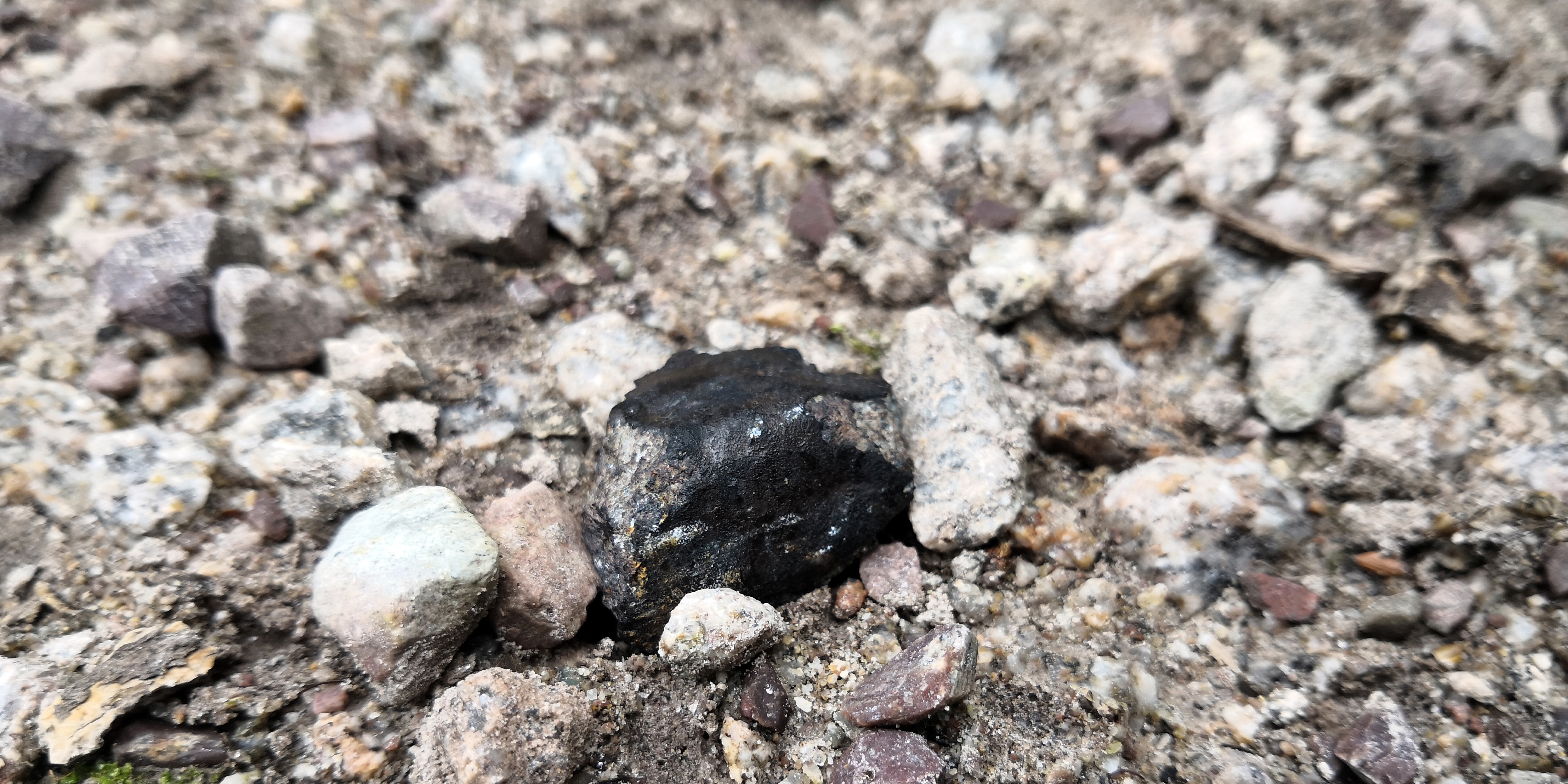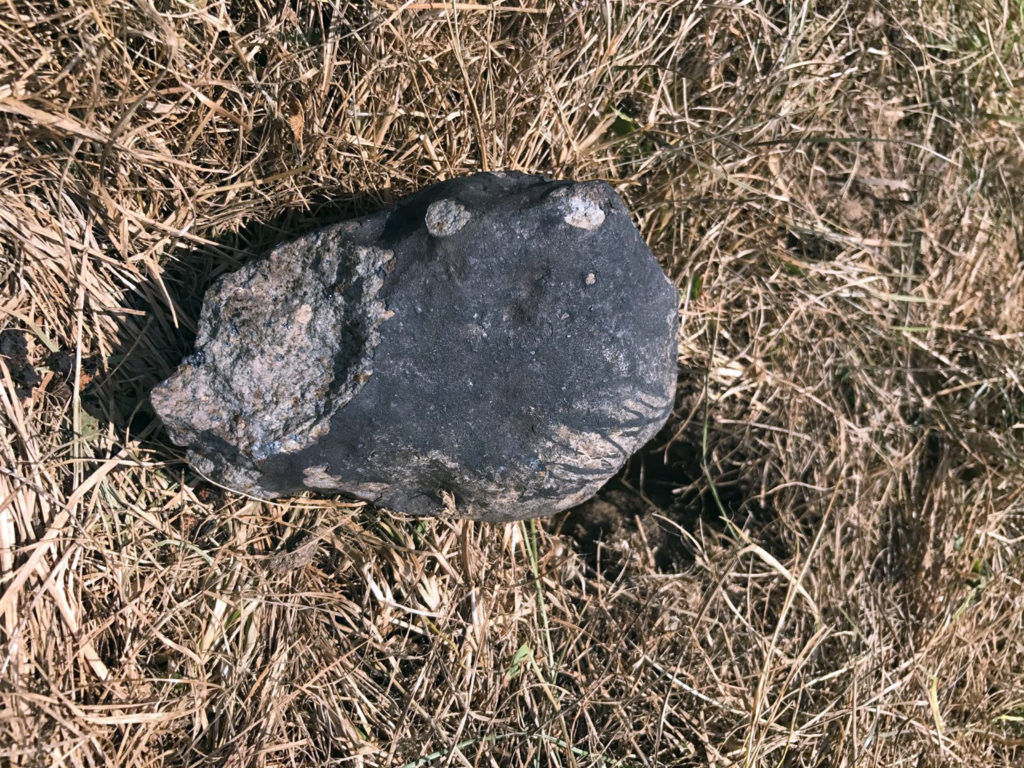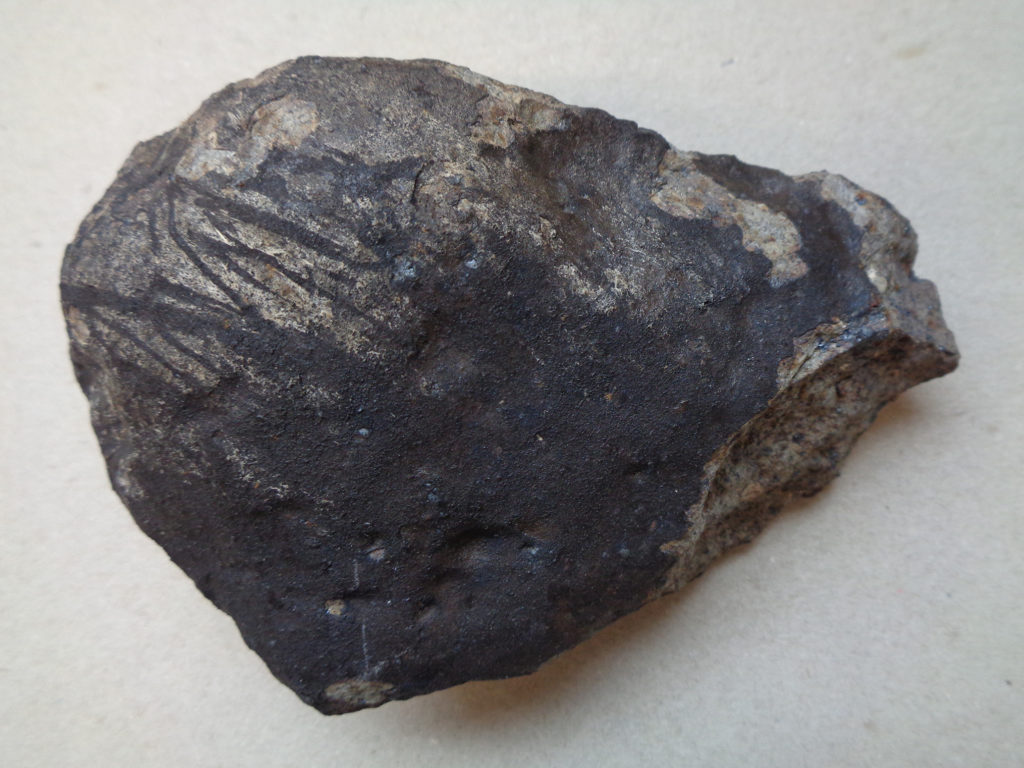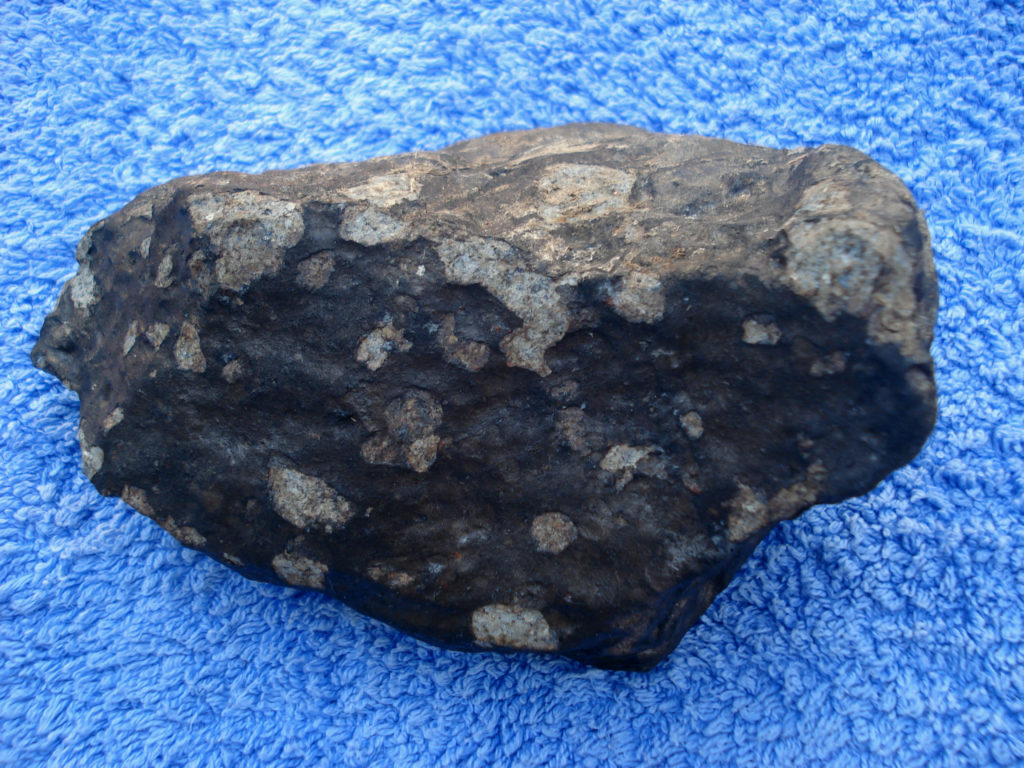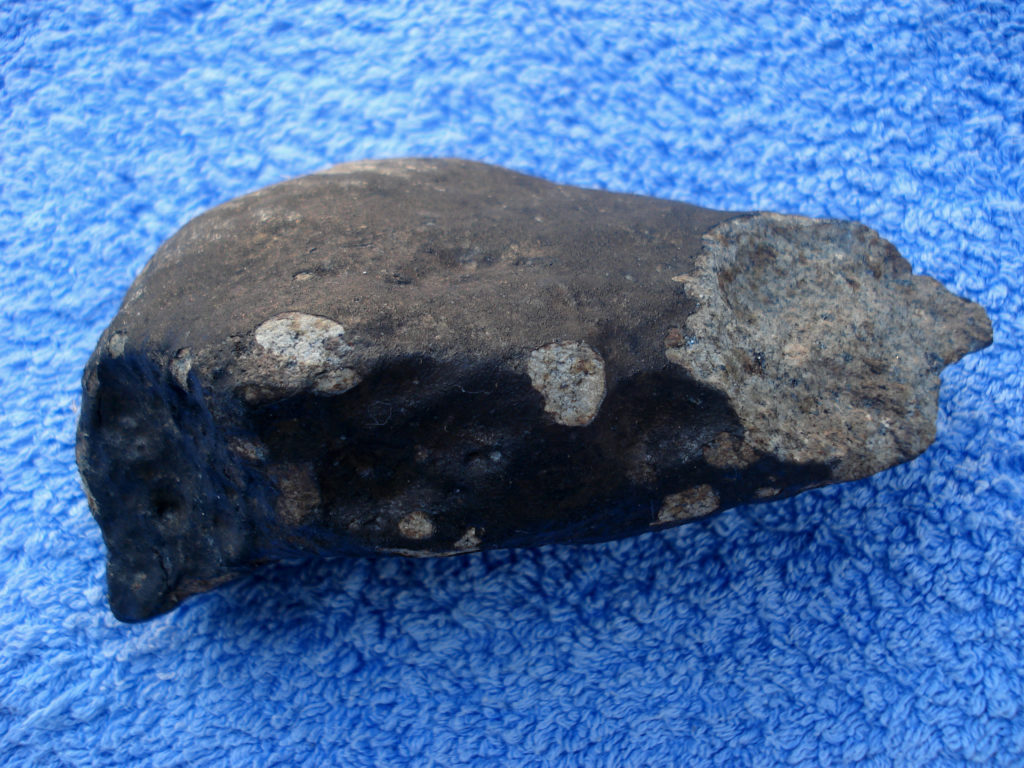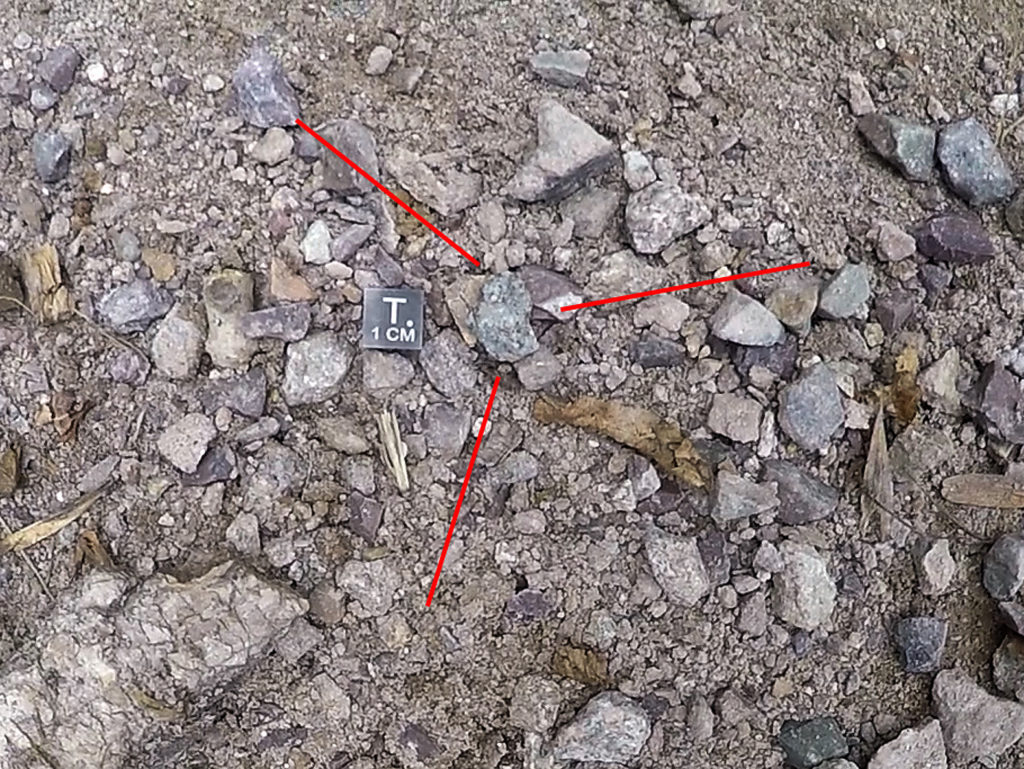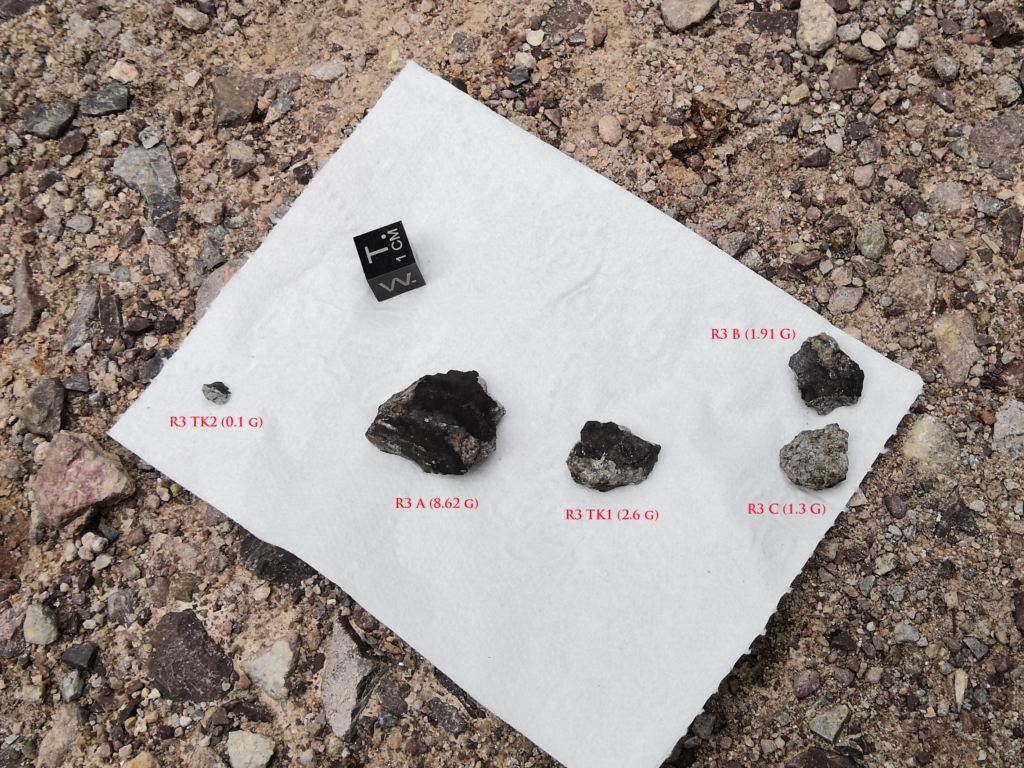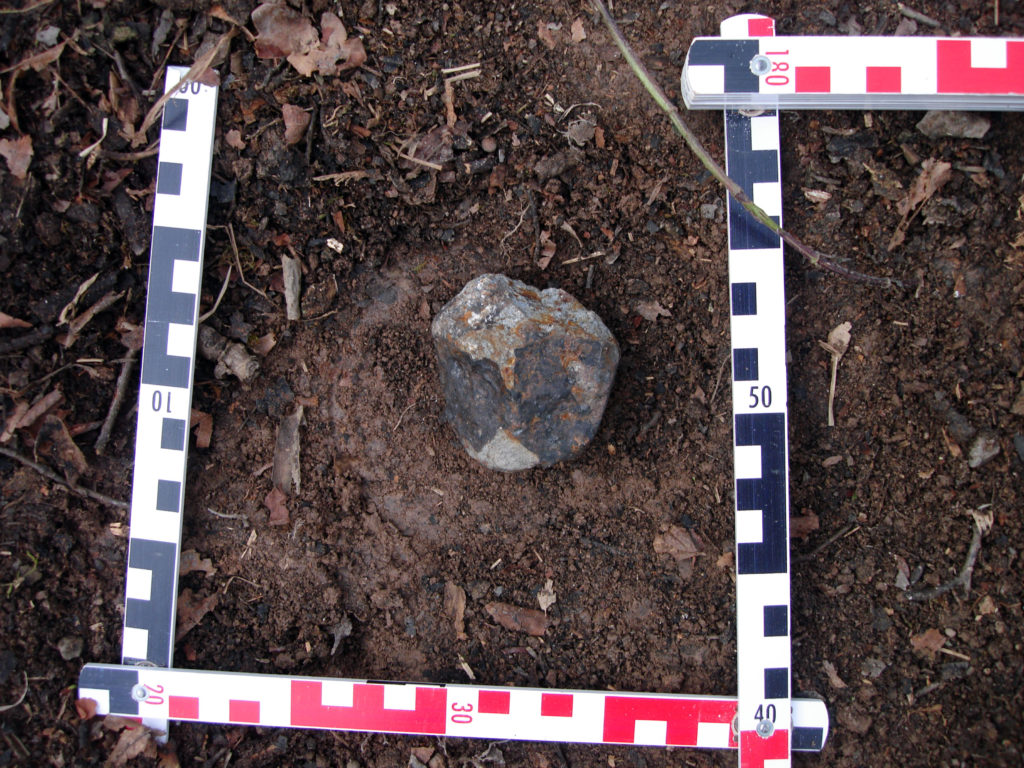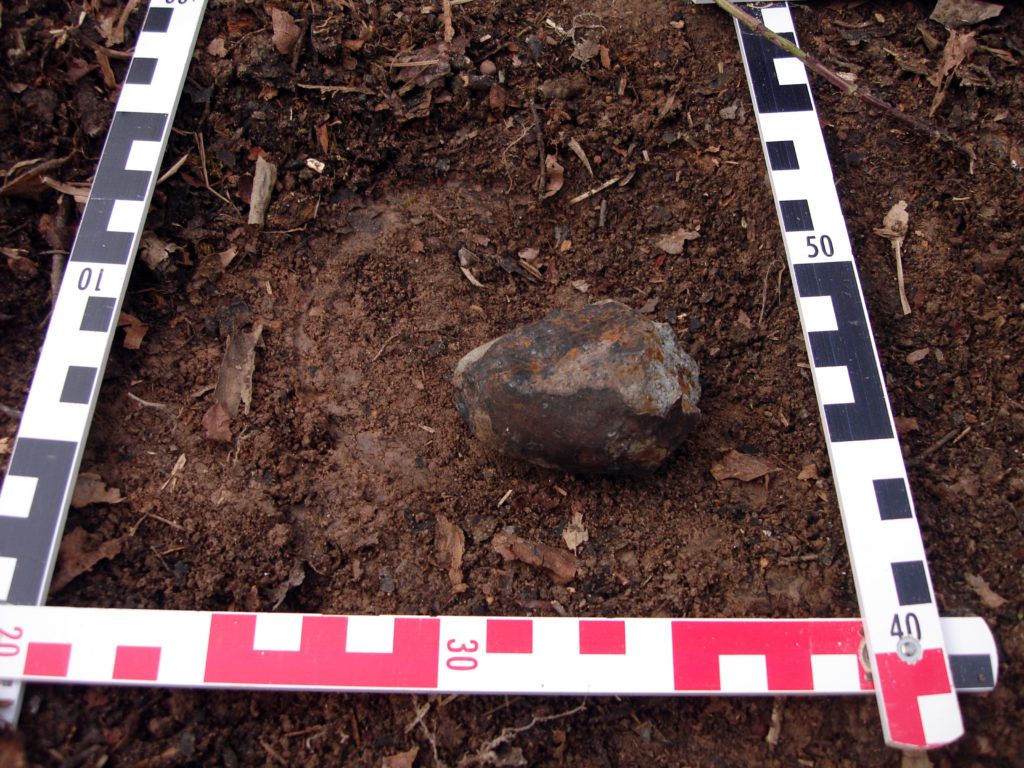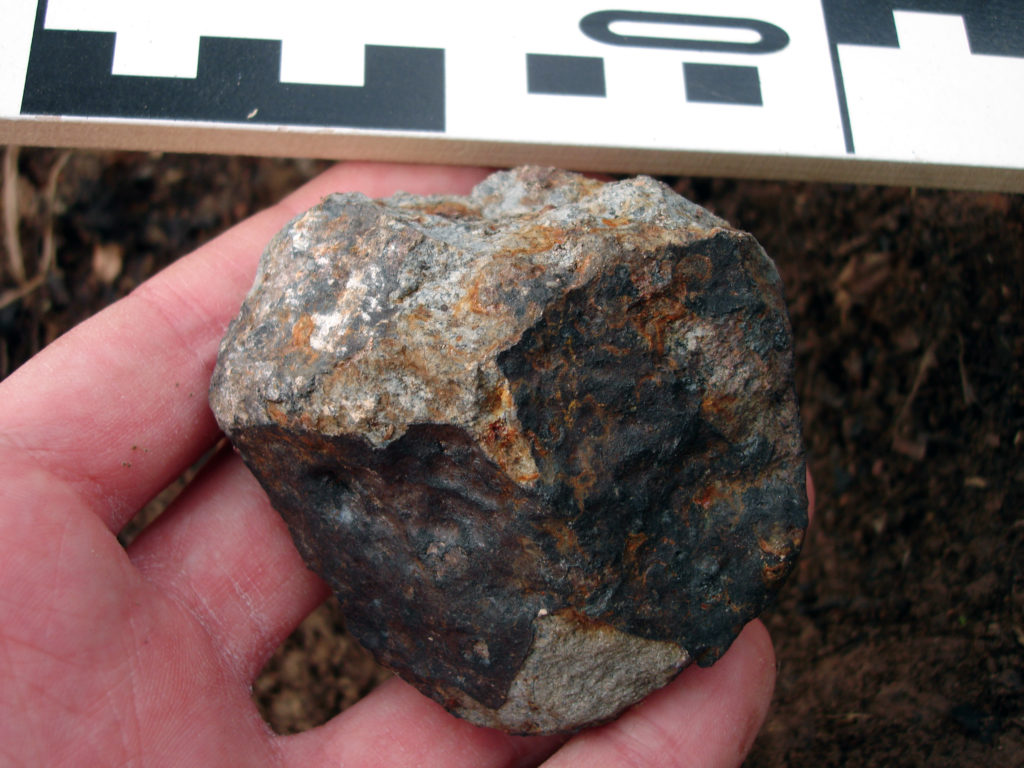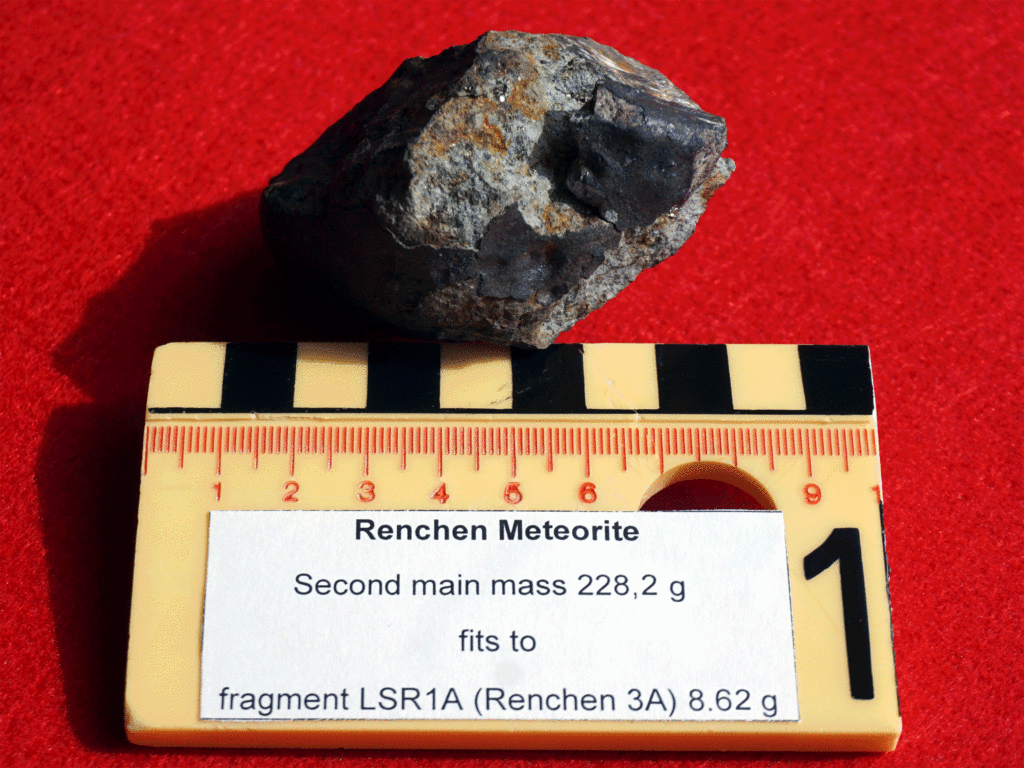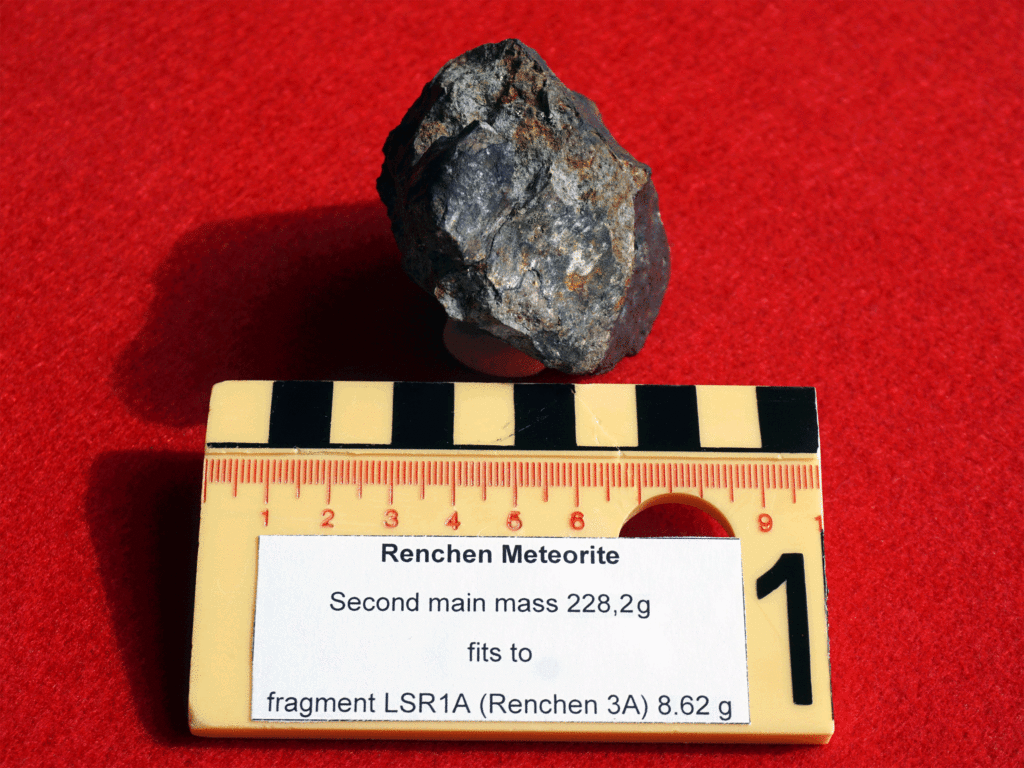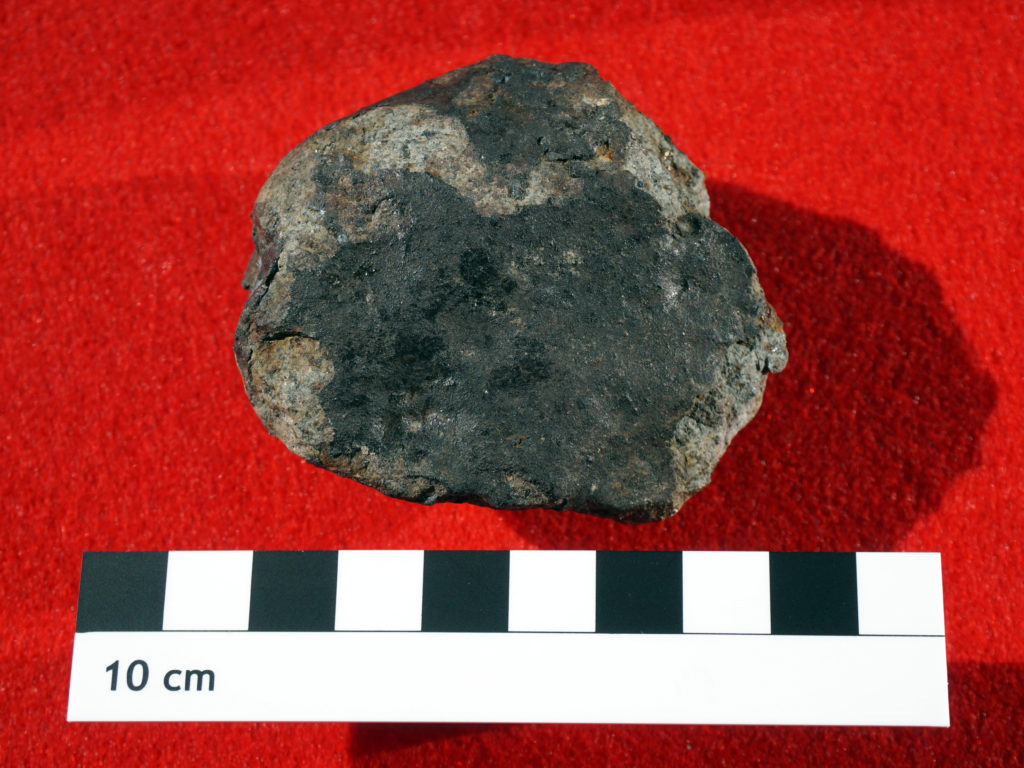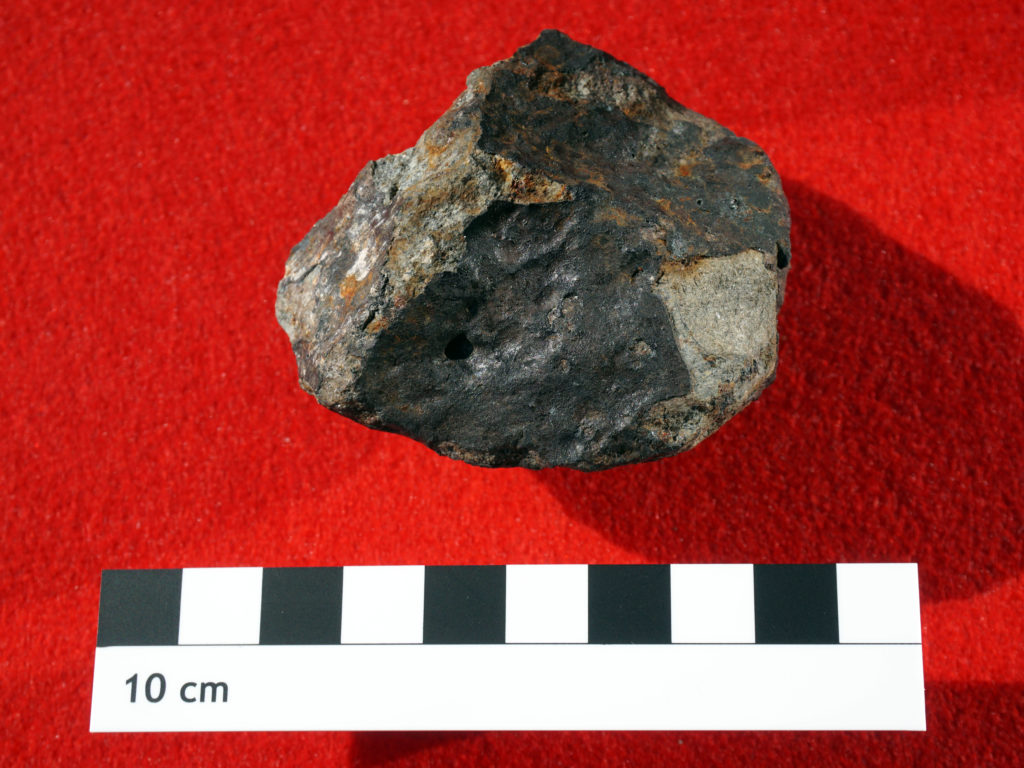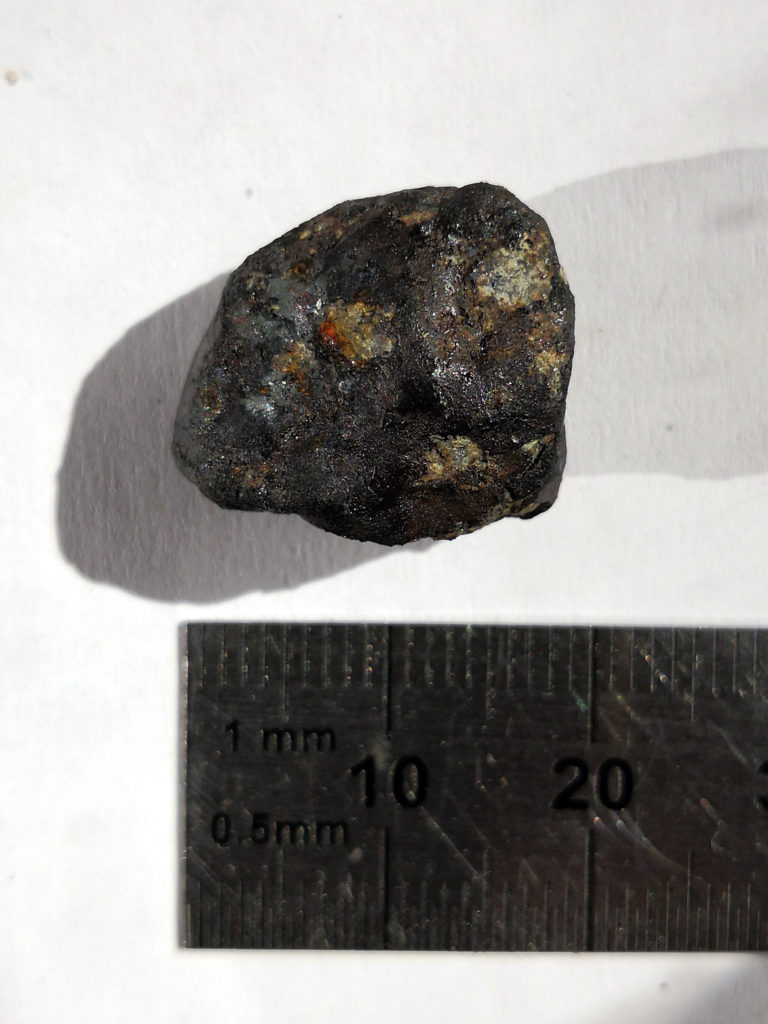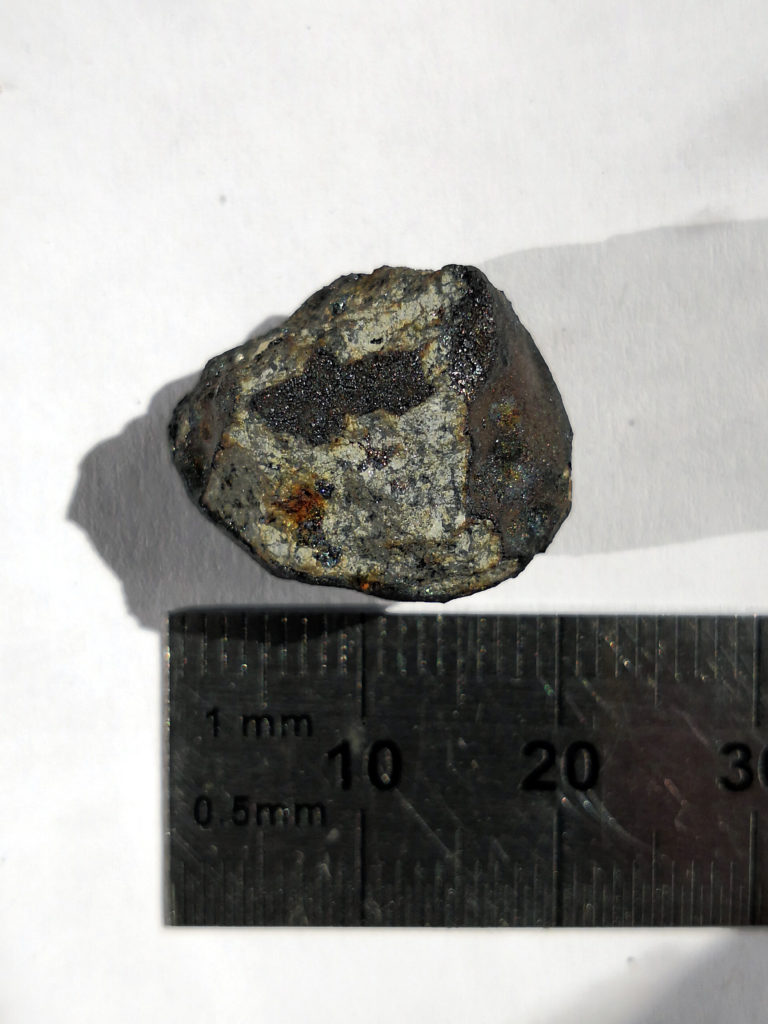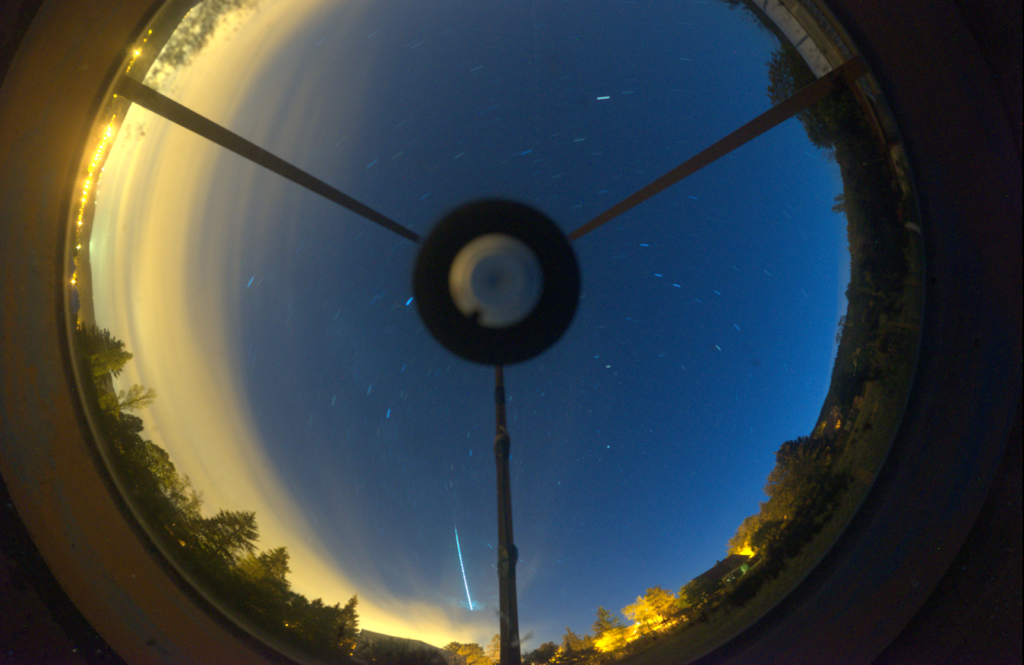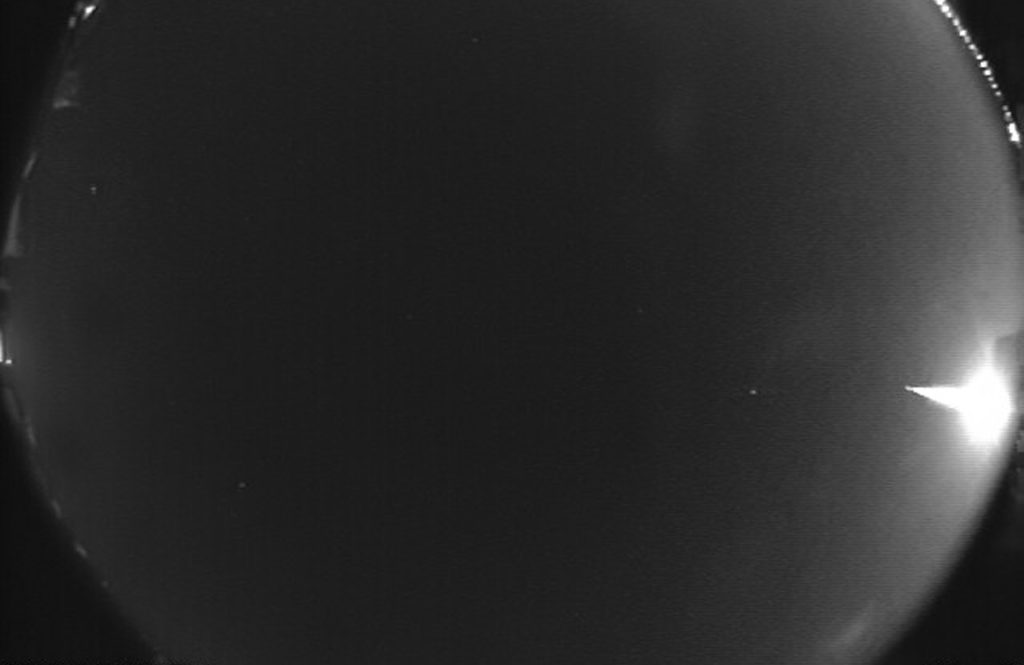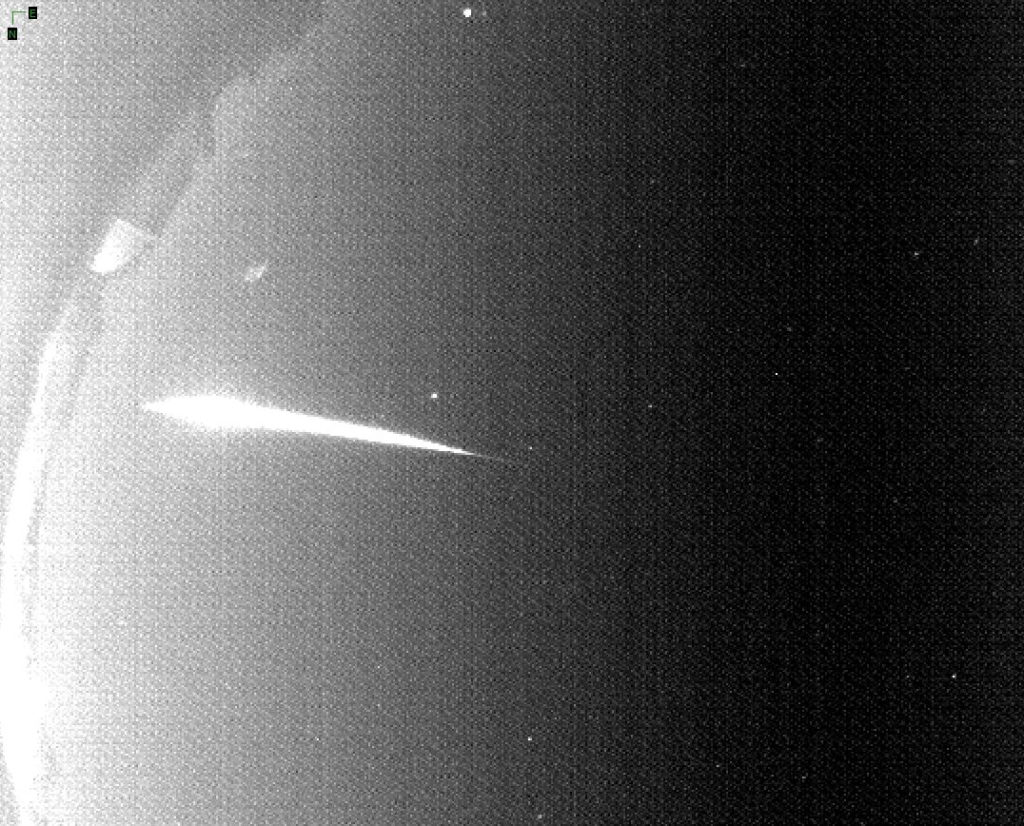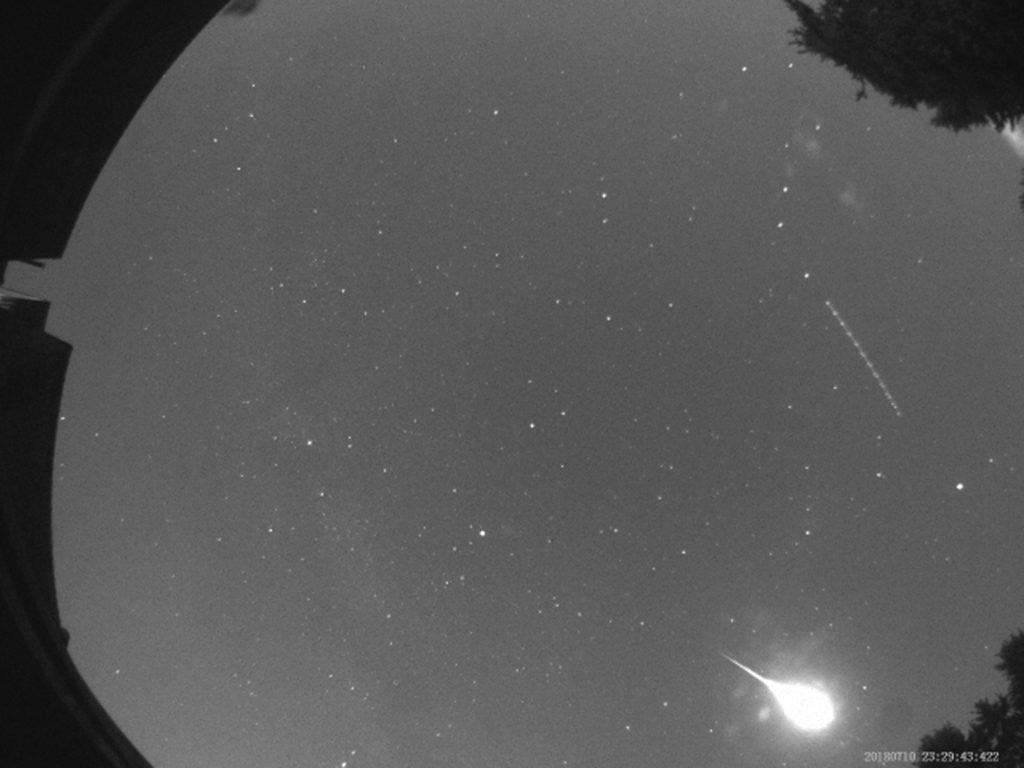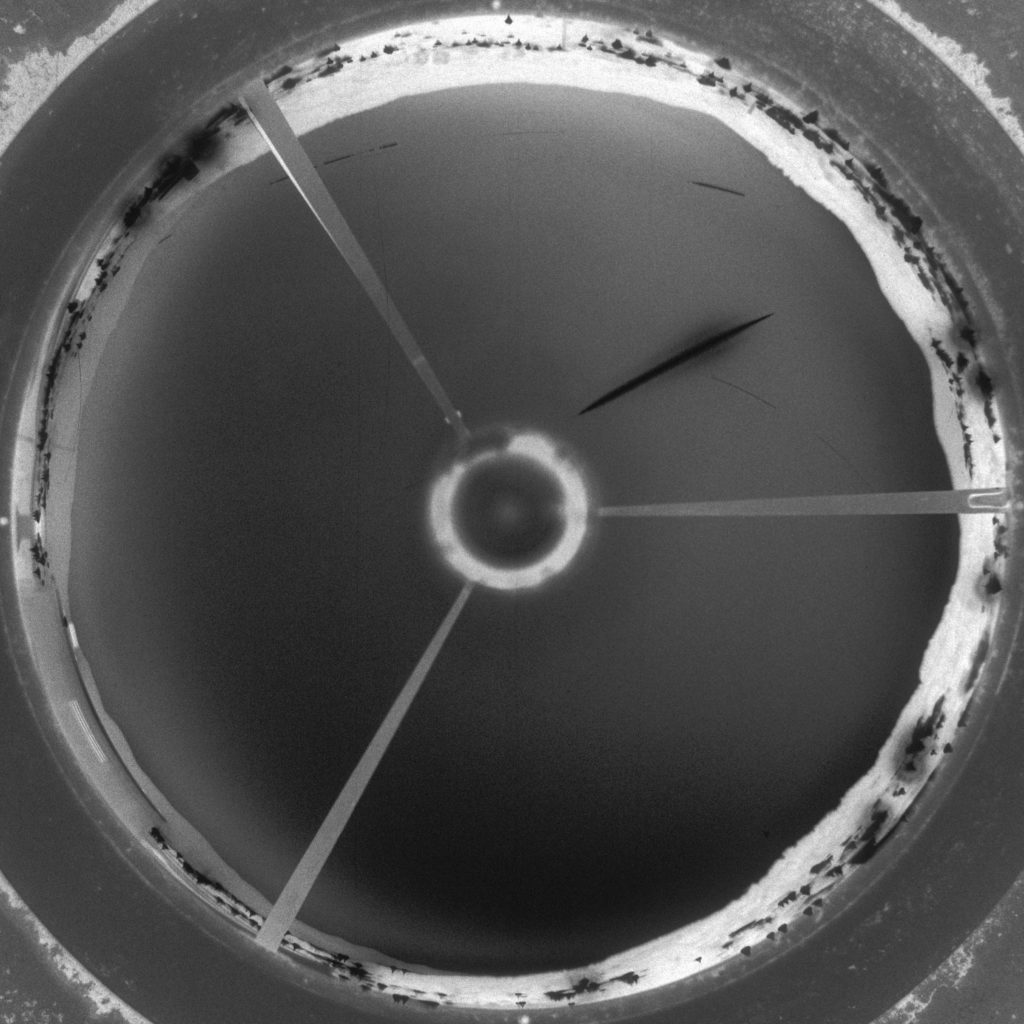Renchen
Meteorite fall (~ 1227.69 g, L5-6, S4, W0) on 10 July 2018 at 23:29:48-52 CEST (21:29:48-52 UTC) near Renchen, Ortenau district, Baden-Württemberg, Germany
The first find (Renchen-1, 11.9 g)
Equipped with a preliminary strewn field map provided by Pavel Spurný on July 14, 2018 and coordinated by Dieter Heinlein the meteorite hunters Ralph Sporn and Martin Neuhofer were sent to the calculated strewn field on 15 July and stayed there until 18 July, mainly to explore the area. Sporn and Neuhofer returned to the strewn field on 22 July and on 24 July around noon Ralph Sporn found Renchen-1 (11.9 g), an almost complete specimen, in a cherry orchard at location 48°34’26.4” N, 8°01’8.8 E, about 1.48 km southeast of Renchen.
The second find (Renchen-2 (main mass), 955 g, now: 868 g)
On 30 July around noon Pavel Spurný transferred another map of the part of the strewn field where larger masses were expected to have fallen to Sporn and Neuhofer who had returned to the strewn field for their third search campaign on 29 July. On 31 July Ralph Sporn and Martin Neuhofer found a large mass of 955 grams (281.420 cm³) with broken faces next to a small shallow impact pit on the eastern edge of a meadow near the Heuweg, east of Holchenbach in the south of the communal district Rheinau between the forests Korker Wald and Hürbewald about 5.4 km north-west of Renchen (48.610222, 7.948167). The unbroken chipped side (View A in photo below) of the meteorite was up when it was found a few centimeters north of the impact pit in the dry grass. The locations of Renchen-1 and Renchen-2 were used by Dr Spurný to refine his strewn field calculation by 8 August 2018. Radio nuclides of the specimen have been measured at Max-Planck-Institut für Kernphysik (MPIK) in Heidelberg. The soil around and including the impact hole has been cut out and saved by the finders, similar to what has recently been done with the impact pits of the Stubenberg and Mangui falls. A chunk of 81.6 grams which includes the type specimen of 20.9 grams was cut off the main mass on 15 November 2018 which left the remaining main mass with a weight of 868 grams.

The cut main mass of 868 grams as it was presented in Renchen on 15 October 2019. Two larger inclusions can be seen on the cut surface with its maximum width of 6.3 centimetres. Photo: karmaka
The third find (Renchen-3 fragments, ~20.57 g)

At 11.40 a.m. on 1 September 2018 the team of Łukasz Smuła, Magdalena Skirzewska and Thomas Kurtz found 19 fragments weighing between 8.62 and 0.18 grams of a meteorite fragment on a forest path in the Mührig state forest within the communal district of Renchen, Landkreis (district) Ortenau, Baden-Württemberg, Germany. The meteorite, most likely one of the fragments which broke off the 955-gram mass Renchen-2, fragmented on impact on the gravel path and broke into at least 19 pieces and several smaller sub-0.1-gram fragments. Four larger fragments were found along a more than 317 centimeter long line crossing the path from southwest (~226°) to northeast. The distances between the find locations of the fragments are: R3B&C ← >132cm → R3TK1 ← ~82cm → R3A ← ~102.5cm → R3TK2). The three fragments R3B, R3C and R3TK2 were found in the grass next to the path and close to the respective crosses on the path.
Smuła and Skirzewska had been searching the area dedicatedly and intensively for more than a week when they teamed up with T. Kurtz on 1 September. The 8.62-gram fragment was found by Łukasz Smuła rather by accident while coming back from the dense undergrowth near a tree plantation southwest of the path where he had looked for meteorites in the high grass with a metal detector. The meteorite fragment stood out from the light-coloured compacted gravel of the forest path because of its fusion crusted surface area pointing upwards. Immediately after the team started looking for more fragments of the meteorite which most likely had shattered on impact on the compacted gravel of the forest path. Four larger meteorite fragments were found on and along the path. On 3 September another fragment was found at the edge of the path about three meters north-northwest from the fall location.
On 12 September two fragments of Smuła and Skirzewska’s meteorite (Renchen 3c and 3r5) weighing 1.298 and 0.054 grams were sent to Prof Dr Addi Bischoff and PhD student Markus Patzek at the Institut für Planetologie at the Westfälische Wilhelms-Universität in Münster for classification. The classification result communicated by Dr Bischoff on 21 September indicate that Renchen is an L-chondrite breccia (L5-6, S4, W0). On 24 December RENCHEN was officially registered in the Meteoritical Bulletin Database.
Main mass of Renchen-3 [Renchen-6]
(228.2 g / 67 x 63 x 41 mm / ~69.7 cm³)

Renchen-3 main mass [Renchen-6] (67 x 63 x 41 mm) near its find location on 23 February 2019. Photo: Thomas Kurtz
In the evening of 23 February 2019 we received the first information by Thomas Kurtz of the find of a new Renchen meteorite which had been found by himself and Dr Oliver Sachs in the afternoon of that day. Since Thomas Kurtz had joined Łukasz Smuła and Magdalena Skirzewska to search for Renchen meteorites on 1 September 2018 he had assumed that there had to be another bigger fragment of Renchen-3, estimated to weigh about 70 grams. It was geologist Dr Oliver Sachs who motivated Kurtz to search the fall location of Renchen-3 again. Sachs had already searched the strewn field in August 2018. Sachs and Kurtz are the chairmen of the friends’ association of the RiesKraterMuseum in Nördlingen and during one of their meetings Sachs had the idea to search for the sticks which had been used to mark the locations of the Renchen-3 meteorite fragments on the forest path in order to collect them together with some gravel of the path for a planned reenactment of the find situation of the Renchen-3 fragments. Because of bad weather the search had to be postponed several times. When they learned that Dieter Heinlein was about to deliver a speech on the Renchen meteorite fall in the Stuttgart Planetarium on 22 February 2019 Kurtz and Sachs decided to go there and then go to Renchen again the following Saturday.
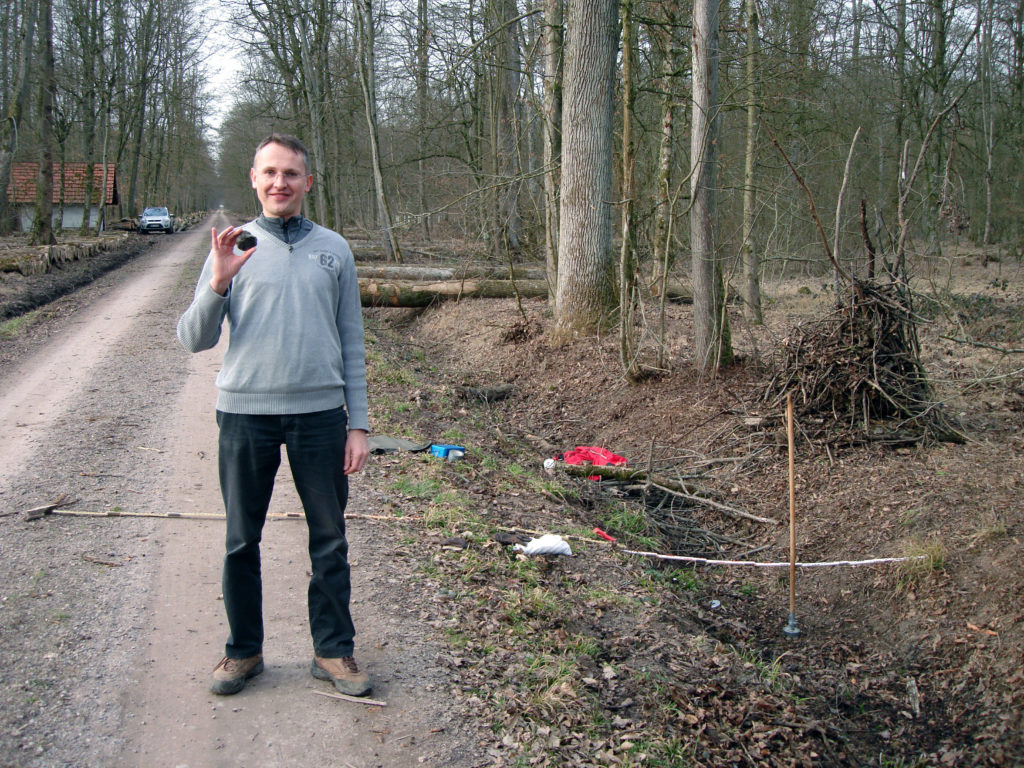
Thomas Kurtz holding the Renchen-3 main mass at 4.13 pm on 23 February 2019. On the right the find location inside the eastern ditch can be seen marked with a magnet stick. The heap with the removed branches can be seen behind it. On the left the wrongly assumed find location of the Renchen-3A fragment on the path can be seen. Photo: Thomas Kurtz/Oliver Sachs

The find location of the Renchen-3 main mass at the bottom of the ditch as marked with a wooden magnet stick. In the top left corner of the photo above a 50-cm layer of branches and leaves can be seen. The find location was originally equally covered with branches, twigs and foliage before Kurtz removed them. Photo: Thomas Kurtz/Oliver Sachs
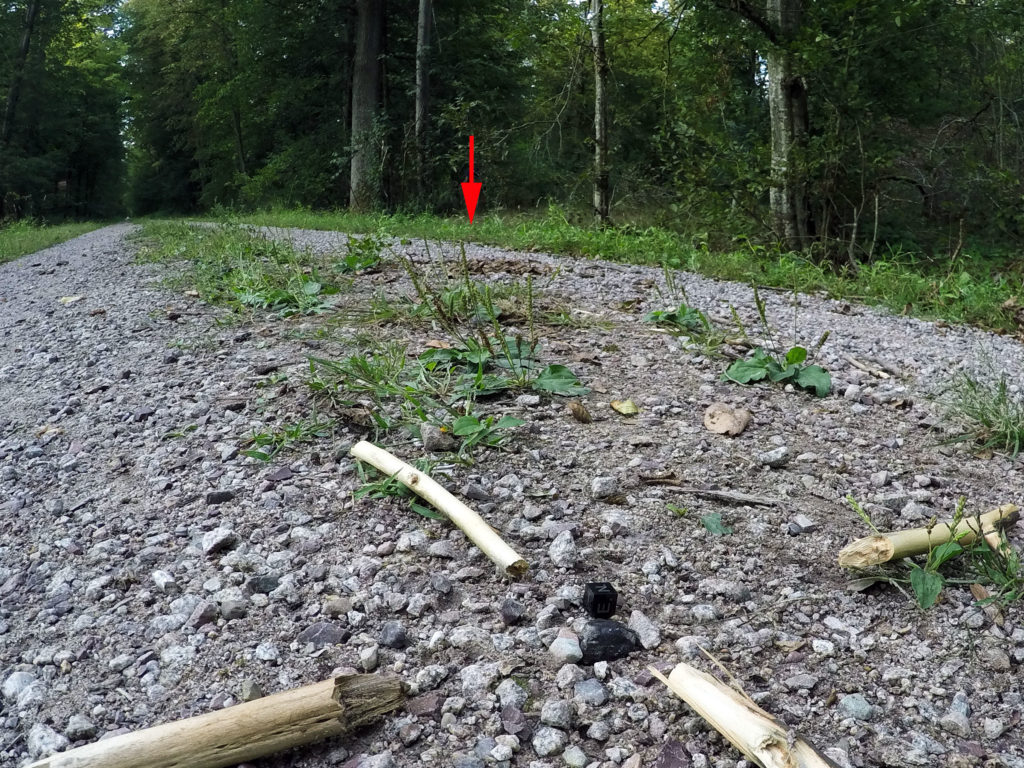
Find location of Renchen-3 main mass (red arrow), seen from find location of fragment Renchen-3A. Photo: Ł. Smuła, M. Skirzewska

Dr Oliver Sachs (left) and Thomas Kurtz (right) at the find location of the Renchen-3 main mass [Renchen-6] on 23 February 2019. Photo: Oliver Sachs
In the afternoon of 23 February 2019 after having searched the eastern ditch with his magnet stick for about one hour Kurtz decided that there were too many branches and leaves making the search inside the ditch ineffective. He then spent about four hours removing those branches, twigs and leaves, piling them up and ‘scanning’ the ground with a magnet repeatedly while Sachs was searching an area 15 to 20 meters away. Suddenly at around 4 p.m. Kurtz hit something hard with his left shoe. He reached into the 20-cm layer of leaves and twigs still covering the ground and grabbed the hard object he had just hit. While picking it up he was immediately aware that he had found the Renchen-3 main mass [Renchen-6], almost 228 days after its fall, inside the eastern ditch about four meters away from the centre of the path. Thanks to the finder’s awareness the meteorite was fortunately not exposed to the artificial magnetic field of a permanent magnet. Kurtz needed to tell Sachs twice that he had found a meteorite before he could believe it and then rushed to join Kurtz at the find location. They noticed that both the 8.6-gram fragment of Renchen-3 (found 175 days before) and the new specimen had the same light greyish scratches on the fusion crust which resulted from the impact of the meteorite on the surface of the gravel path. Later Oliver Sachs searched the find location of the Renchen-3 main mass again with a strong magnet and found a crustal fragment (9.2 x 5.5 x 1.9 mm) of 73 mg. With this new find the total weight of Renchen-3 is 248.8 grams.
Errors, chance and meteorite finds
Back at the fall location on 23 February Kurtz determined the find location of the Renchen-3 fragments from memory and actually missed it by about 9 meters to the north. Thinking that he was searching the eastern ditch at the height of the find locations of the Rechnen-3 fragments he was actually searching an area in the eastern ditch a few meters north of it which had not been searched by other meteorite searchers with detectors or magnets during the months since the fall. Fortunately the ground in the ditch and the area around had equally not been physically modified by forestry workers as it had been done in and around the western ditch of the forest path. This orientation mistake and a reliance on memory rather than on photographic documentation had most likely made the find of the Renchen-3 main mass [Renchen-6] possible in the end. To determine the terrestrial age of the Renchen-3 main mass [Renchen-6] it was brought to Max Planck Institute for Nuclear Physics in Heidelberg for an analysis of short-lived radionuclides within the MPI’s germanium gamma spectrometer GIOVE (Germanium Inner Outer VEto) by Janina Hakenmüller. The meteorite was delivered to the MPI during the first week of March 2019. The analysis procedure took about three weeks and the meteorite was kept at the MPI until 5 April. Then Dr Karl Wimmer measured the magnetic susceptibilty with an SM30 meter. On 7 April the meteorite was given to Dieter Heinlein for density measurements.
Renchen-3A as fragment of the Renchen-3 main mass [Renchen-6]
Click on the images to see the animations
The fourth find (Renchen-4, 4.8 g)
Just after noon on 30 September 2018, on their 26th day of searching in the strewn field, Sporn and Neuhofer found another meteorite weighing 4.8 grams at a height of 2.5 meters above the ground in a hail protection net above a raspberry plantation, east of Renchen.
The fifth find (Renchen-5, 6.29 g)
At 1.08 p.m. on 13 October another intact specimen (18 x 16 x 13 mm) weighing 6.29 grams was found by Martin Kappler after 94 hours of systematic search during his 18th search within the strewn field.
The bolide (EN 100718)
The bolide’s luminous trajectory was recorded for about 4 seconds at ~23:29:48-52 CEST (21:29:48-52 UTC) on 10 July 2018. The bolide was recorded by several meteor cameras of the European Fireball Network (EN) in Germany and the digital automatic all-sky cameras (DAFO) in the Czech Republic. It was recorded on the digital DLR mirror camera in (78) Osenbach in Alsace, France (88.4 km from the fall location of Renchen-1) and the two German analog cameras in 87 Gernsbach (31.23 km from the fall location of Renchen-1) and 43 Öhringen (130.5 km from the fall location of Renchen-1). A digital camera at the Czech Hydrometeorological Institute in Přimda (361.1 km from the fall location of Renchen-1) and another in Churáňov (414.5 km from the fall location of Renchen-1) in the west of the Czech Republic equally captured the bolide very low above the horizon (Přimda: 10.4°-0.8°). Furthermore some private digital skycams in Karlsruhe-Knielingen (by Uwe Baron), Oberwolfach (by Martin Rebbe), at the observatory Welzheim (by Steffen Brückner) and in Schwarzenberg (by Rene Zinke) could capture it. In France a private digital camera in Chaligny (142.7 km from the fall location of Renchen-1) recorded the bolide’s luminous trajectory. Another capture is known from Schafmatt in Switzerland. The bolide was observed by several eye-witnesses in Germany, France, the Netherlands and Switzerland. The known data provided enough information to calculate the meteoroid’s pre-impact heliocentric orbit, its atmospheric trajectory, its dark flight trajectory and the potential fall area of meteorites.
The analysis of the luminous and dark flight trajectory was performed within one day by Dr Pavel Spurný and a team of the Interplanetary Matter Department at the Astronomical Institute of the Czech Academy of Sciences (CAS) in Ondřejov. The wind models were provided by Dr Gerd Baumgartner of the Leibniz-Institute of Atmospheric Physics in Kühlungsborn. According to P. Spurný’s calculation a meteoroid the size of a football was recorded entering the atmosphere with a speed of slightly below 20 km/s in a very steep angle of 80 degrees to the surface and started to radiate light at a height of 80 km above an area halfway between Waldulm (Kappelrodeck) and Ringelbach (Oberkirch). The bolide’s brightness increased rapidly and reached its maximum magnitude of –13.4 (recalculated value for a distance of 100 km). The luminous trajectory, containing one distinctive flare (after about 3 seconds) at a height of 28 km, lasted for about 4 seconds. It was about 63 km long and ended at a height of about 18 km above the ground slightly west of Renchen, Germany. The dark flight of a one-kilogram meteorite starting at the end point of the trajectory at a height of 18 km above the ground lasted for about 2 minutes. The smaller masses of about 1 to 10 grams resulting from the main flare at an altitude of 28 km took about 5 to 10 minutes to fall to the ground.
The strewn field of bolide EN100718 was determined to be in the Ortenau district near the small city of Renchen in western Baden-Württemberg, Germany. The calculated ~12.9-km² strewn field consists of two distinctive areas: a broad area in the southeast where a few dozens of smaller masses of 1 to 50 grams resulting from the bolide’s main flare are expected to have fallen. Smaller specimens of about 10 grams are expected to have fallen above the city of Renchen and smaller masses of about one gram are expected to have fallen along a line stretching between the villages of Stadelhofen and Ulm. Larger fragments are expected to have fallen in the Mührig and Hürbewald forests within a small strip of the strewn field northwest of the motorway. In the morning of 2 October 2018 Dr Pavel Spurný published his press release (PDF/DOC) / English version about this fall. A German version (PDF) of the press release written by Dieter Heinlein with a slightly different content can be downloaded here: German version (PDF). On 4 October Westfälische Wilhelms-Universität Münster (WWU) published its press release.
Bolide recorded from Chaligny, France, 142.7 km from the fall location of Renchen-1. Video: M. Herrault

